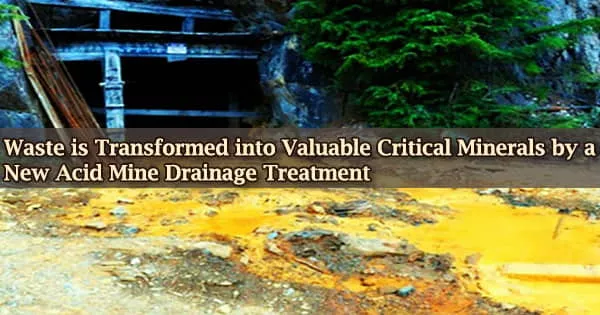According to Penn State scientists, a new approach to remediate acid mine drainage (AMD) could help turn the environmental pollution problem into an essential domestic source of the critical rare earth elements needed to manufacture technology ranging from smartphones to fighter jets.
“Acid mine drainage has been a significant environmental concern for many decades,” said Mohammad Rezaee, assistant professor of mining engineering in the College of Earth and Mineral Sciences at Penn State.
“This research shows we can modify existing treatment processes in a way that not only addresses environmental concerns but at the same time recovers valuable elements and actually decreases the cost of treatment.”
Penn State researchers created a two-stage treatment technique that allowed them to recover larger concentrations of rare earth elements with fewer chemicals than was previously achievable, according to the researchers.
“This technique represents an efficient, low-cost, and environmentally friendly method to extract these valuable minerals that are used in a wide variety of consumer and industrial products,” said Sarma Pisupati, professor of energy and mineral engineering and director of the Center for Critical Minerals at Penn State.
Rare earth elements are a set of 17 minerals that are commonly employed in modern technologies and have been identified as essential to the United States’ economic and national security by the U.S. government. Currently, the United States imports nearly all of these resources, with China generating around 85% of the global supply.
Acid mine drainage has been a significant environmental concern for many decades. This research shows we can modify existing treatment processes in a way that not only addresses environmental concerns but at the same time recovers valuable elements and actually decreases the cost of treatment.
Mohammad Rezaee
Because it often contains high quantities of rare earth elements and is already being collected and treated due to environmental concerns, AMD from coal mining operations in Appalachia represents a prospective domestic source of rare earth elements, according to scientists.
“We are currently incurring costs just to treat the water, and in many cases, we are not even collecting all these minerals,” Pisupati said. “Now we are able to turn what had been considered a waste product into a valuable resource.”
When pyrite rock iron sulfide, which has been uncovered by mining activities, combines with water and air, it oxidizes and produces sulfuric acid. According to the experts, the acid subsequently breaks down surrounding rocks, allowing dangerous metals to dissolve into the water.
Traditional treatment methods include collecting AMD in retention ponds and adding chemicals to neutralize the pH, which is a measurement of how acidic or basic a substance is. The dissolved metals precipitate or solidify, and settle out of the water as a result.
According to researchers, this procedure can remove up to 70% of rare earth elements as a sludge, with the rest being released along with the cleaned water.
The researchers discovered that adding carbon dioxide to the AMD and then getting it to a neutral pH of 7, the objective for environmental cleanup, in two different processes allowed them to extract a higher concentration of rare earth metals and other essential minerals.
The authors reported in Chemical Engineering Journal that using this approach, 90 percent of aluminum was recovered at pH 5 and 85 percent of rare earth metals were recovered at pH 7.
According to the researchers, adding carbon dioxide to AMD causes chemical processes that end in the production of solid minerals known as carbonites. At lower pH values, the rare earth elements link with the additional carbonites and precipitate out of the water.
Carbon dioxide mineralization is a new technology that is being used to extract excess carbon dioxide from the environment. According to the researchers, this is the first time it has been utilized to extract substantial amounts of rare earth metals from AMD.
Using typical treatment procedures to recover the same concentration of rare earth elements from AMD would necessitate the use of additional chemicals to raise the pH above 7. According to the researchers, the new treatment approach could make the domestic rare-earth element market more competitive by cutting recovery costs.
“With a simple modification of existing treatment processes, the industry could use less chemicals and get more value out of AMD waste,” Rezaee said. “This is the beauty of this research.”





